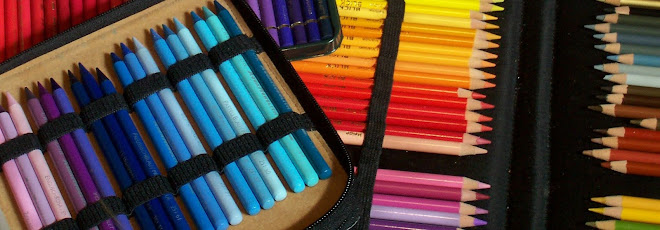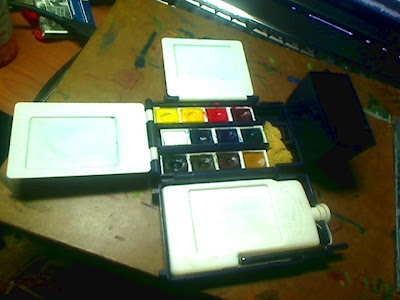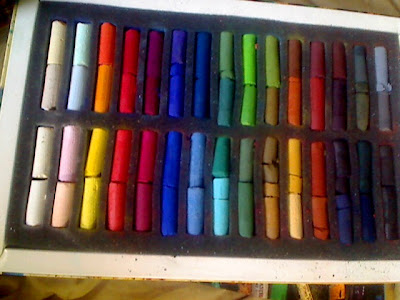
Faber-Castell created the Polychromos System, matching colors on their hard pastels, colored pencils and Albrecht Durer watercolor pencils for ease in using their products together on mixed media. Polychromos colored pencils are medium-soft, nowhere near as smudgy and easily blended as Prismacolor or Coloursoft, but much softer than student grade colored pencils. They're pigment-rich and have a slight slippery feel on the paper, blending well with firm pressure. Unlike wax-based colored pencils, they aren't subject to wax bloom.
I bought the 120 color full range tin, you can see half of the range in the Global Classic leather case that I keep it in. The pencils are enameled all the way down with a little gold band near the dipped ends. They're round, but narrow enough to use a standard sharpener and will hold a very fine point well, just like Prismacolor Verithin. I think they are more pigmented than Verithin and find them more opaque. Not quite as opaque as Coloursoft, but more than many artist grade brands.
Another great advantage of the Faber-Castell Polychromos colored pencils is that they are all labeled for lightfastness. Everything in the range has either * for lightfast, ** for good lightfastness or *** for excellent lightfastness. If you're looking for a large set and concerned about archival quality, Polychromos is a good choice. Price is about mid-range for a good artist grade colored pencil.
The full color 120 pencil tin also comes with a CD of art instruction that is the same CD for all the Polychromos products. It includes a tutorial on using colored pencils, on mixed media, on watercolor pencils and on pastels in a variety of language. The techniques in the tutorial are more impressionist than the fine-detail colored pencils realism that's so popular, but very striking and I found the tutorial useful.
These pencils work well on colored papers like Canson Mi-Tientes smooth side, just translucent enough for the paper color to affect the whole but opaque enough that complements can be brought to full brightness on it. Many of the examples in the DVD tutorial were done on tinted paper in strong colors.
Like Derwent Artist's colored pencils, Faber-Castell Polychromos are very good for a tonal drawing that uses the white specks of the paper for shading. They will hold a fine point and with heavy pressure can be used to incise a fine line to work lightly over with softer pencils or with lighter pressure and darker Polychromos pencils. Their medium softness gives them versatility allowing both hard-pencil techniques and soft-pencil techniques to work equally well and strong pigment makes them very good for opaque passages and pure color when needed.
Faber-Castell Polychromos will blend well with odorless mineral spirits, Bestine rubber cement thinner and turpentine substitutes for wash effects. I prefer using them on fine-grained papers with a vellum or toothy surface. Stonehenge is great with them, but smooth side Canson mi-Tientes is also good and I've had good results with sketchbook paper which I think is similar to cartridge paper in tooth and surface.
The color range is strong on brights and seems to relate to a designer's range, there are many even hue divisions around the spectrum, red-oranges and blue-greens and blue-violets one step farther along the range. It's evenly divided around the spectrum with a lot of yellows, oranges and reds. There are a few useful tints, pinks and light blues, but no extra-light tints in the range. For extra-light tints, go lightly and burnish with white.
The earth tones range is beautiful. Cool blue-grays, warm grays and nearly brown French grays each have several values, then there's a nice variety of yellowish, reddish, pinkish and dark browns. They include a couple of skin-tone highlight colors and ever-useful Cream. Greens include some muted hues, gray-greens and olives as well as spectrum bright greens. Deep darks are represented around the spectrum if you consider several shades of yellow ochre as the dark range of yellow.
The large range with its emphasis on spectrum brights demands a little knowledge of color, mixing and creating values by pressure. It has fewer convenience colors than other large ranges, what it has is pure tertiary hues with high intensity. For someone who loves to mix colors, this set is a joy. You can always mute a color by adding a little of its complement or near-complement, but you can never mix a color as bright as starting with a pencil that hue -- and if you need exactly that yellow-orange for a detail in a flower center, that's a convenience too.
If you're a beginner, the Faber-Castell Polychromos large set will teach color mixing and tonal value adjustments. The pencils respond beautifully to any degree of pressure, laying down well with feather-light touches for a dry glaze that barely changes the color of the paper and burnishing several layers with a heavy application or incising lines with a very sharp point to work around. For an intermediate to expert colored pencil artist, these are good archival oil-based colored pencils that may have exactly the right texture for your hand and your style.
Try a few of them from open stock or a small set of 12 or 24 before investing in the big set. All of the artist grade brands that have a 120 color range are good in their own ways for different styles. Polychromos is one of the most versatile -- if you learn to mix colors and use light pressure and white burnishing to create pale tints.
Here's an example of a drawing I did with Faber-Castell Polychromos, done from life on white sketchbook paper for a Scavenger Hunt event on http://www.wetcanvas.com. I used a soft tonal layer for the shadow of the brush and two or three layers of blended golds and browns for the brass, the black part of the handle is done with black, dark blue, dark green, dark red and a couple of cool grays under the highlights. The fine points gave me beautiful precision for the lines in the brush head and tiny details along the handle. I love these pencils but they may not be for everyone, so try a few before buying the big set.

Travel Brush
4" x 7"
Faber-Castell Polychromos on white sketchbook paper, from life.




























